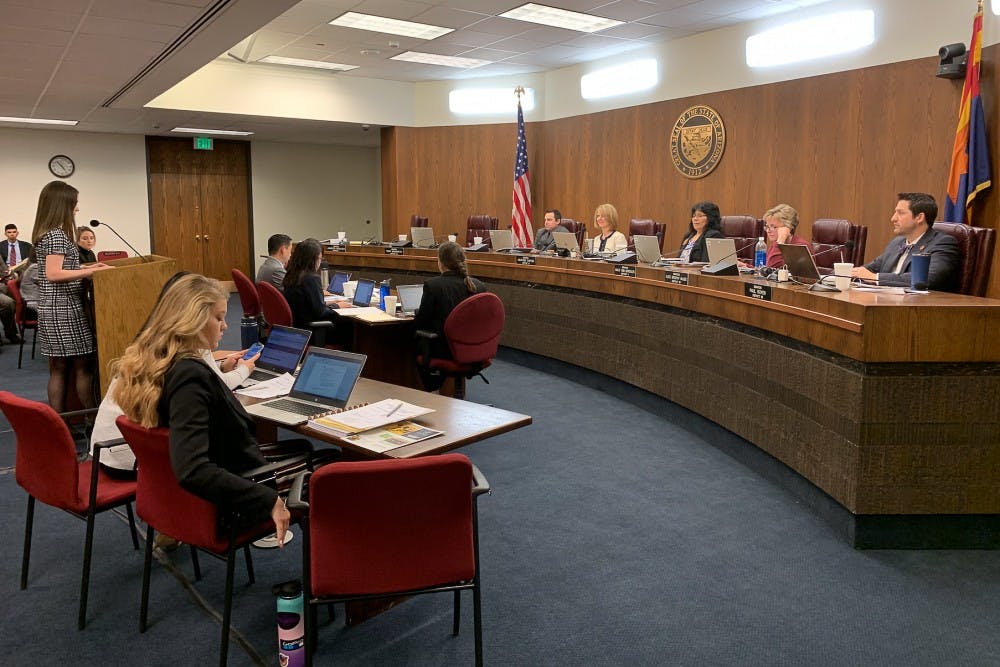Arizona universities could receive a funding increase from the state for the first time in eight years.
That’s the goal of Senate Bill 1518, which garnered the support of the Arizona Board of Regents last week — and made it out of the Higher Education and Workforce Development committee on Monday evening by a unanimous, bipartisan vote.
The bill would increase funding over the next three years, from covering 35 percent of resident tuition up to 50 percent — a proposal ABOR calls the 50/50 model.
ASU law student and Student Regent Aundrea DeGravina testified before the committee on behalf of the Arizona Board of Regents.
"Our universities are stretched thin — they’ve done everything in their means while providing a high quality educational experience," DeGravina said. "The model of relying heavily on out of state and international students to offset the cost of the Arizona students is just too risky."
DeGravina said increasing funding was imperative to Arizona's workforce and economy, and said that the model is about "providing Arizona resident students access to quality higher education while still requiring students and families to financially participate in the endeavor."
The bill comes as discussions around tuition and teachers salaries has put increased pressure on the state to increase higher education funding. ASU President Michael Crow visited the same committee weeks ago to share the same request of an increase to 50 percent funding from the state.
Sen. Heather Carter, R-Cave Creek, said the bill comes after many conversations at the legislature and governor's office.
“This is the bill we’ve all been waiting for, and advocating for, for a long time” Carter said. “This is basically the statutory language of the 50/50 model, this is a bill that I put forth because as you heard … we have spent countless hours in the basement, in the parking lots, on the ninth floor, on the eight floor on the third floor on the second floor … talking about the resident student tuition model – but we’ve never actually seen it in writing so I figured ‘what time like the present than to introduce it'.”
Lorenzo Martinez, the vice president of finance and administration for the Regents said that the bill was a step in the right direction, and that the funding is needed in two primary areas.
"One is attainment — the adult population that has an education above high school is below the national average, and as we look at the future more and more jobs are requiring a higher education," he said.
"So looking to the future, with the current levels, we aren’t going to have enough skilled labor to fill those jobs. So a lot of those resources will go towards getting K-12 students to go on to get a college degree."
The other focus is making sure that students are successful once they get there, and don’t drop out, he said.
A representative from the University of Arizona referred questions to ABOR, and a spokesperson from ASU confirmed that ASU supports the bill.
The bill passing out of committee is significant, DeGravina said.
“I think having a unanimous vote (in committee) shows that people are ready to talk about it, and this is a good sign.”
The bill did not pass without reservations from two senators, J.D. Mesnard (R-Chandler), and Kate Brophy McGee (R-Phoenix), who voted yes for the bill but shared concerns on how the state would pay for the increased funding.
"I support moving in the direction of the 50/50," Mesnard said. "We have to figure out how we are going to pay for this. I want to be very clear that my vote here today does not mean I support taking more from our taxpayers … I would reprioritize within the existing pie."
Those remarks foreshadow the hurdles the bill faces when it makes it to the floor of the Senate.
DeGravina said that phasing in the 50/50 goal over the course of three years made it an easier sell to the legislature.
“I think being able to phase it in, it is easier for the legislature to sell that story,” she said. “Within being fiscally responsible I think it is a story that is easier to sell to legislators so we can ultimately get to the result that we want.”
Reach the reporter at isaac.windes@asu.edu or follow @isaacdwindes on Twitter.
Like The State Press on Facebook and follow @statepress on Twitter.




